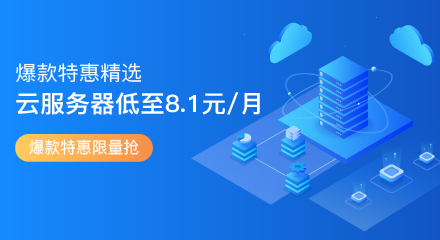Python 被称为是最接近 AI 的语言。最近一位名叫Anna-Lena Popkes(德国波恩大学计算机科学专业的研究生,主要关注机器学习和神经网络。)的小姐姐在GitHub上分享了自己如何使用Python(3.6及以上版本)实现7种机器学习算法的笔记,并附有完整代码。所有这些算法的实现都没有使用其他机器学习库。这份笔记可以帮大家对算法以及其底层结构有个基本的了解,但并不是提供最有效的实现。
在 Logistic 回归中,我们试图对给定输入特征的线性组合进行建模,来得到其二元变量的输出结果。例如,我们可以尝试使用竞选候选人花费的金钱和时间信息来预测选举的结果(胜或负)。Logistic 回归算法的工作原理如下。
给定:
-
数据集

-
 是d-维向量
是d-维向量
 是一个二元的目标变量
是一个二元的目标变量
Logistic 回归模型可以理解为一个非常简单的神经网络:
-
它有一个实值加权向量

- 它有一个实值偏置量 b
- 它使用 sigmoid 函数作为其激活函数
与线性回归不同,Logistic 回归没有封闭解。但由于损失函数是凸函数,因此我们可以使用梯度下降法来训练模型。事实上,在保证学习速率足够小且使用足够的训练迭代步数的前提下,梯度下降法(或任何其他优化算法)可以是能够找到全局最小值。
训练 Logistic 回归模型有不同的步骤。首先(在步骤 0 中),模型的参数将被初始化。在达到指定训练次数或参数收敛前,重复以下其他步骤。
第 0 步:用 0 (或小的随机值)来初始化权重向量和偏置值
第 1 步:计算输入的特征与权重值的线性组合,这可以通过矢量化和矢量传播来对所有训练样本进行处理:
其中 X 是所有训练样本的维度矩阵,其形式为 ;·表示点积。
;·表示点积。
第 2 步:用 sigmoid 函数作为激活函数,其返回值介于0到1之间:

第 3 步:计算整个训练集的损失值。
我们希望模型得到的目标值概率落在 0 到 1 之间。因此在训练期间,我们希望调整参数,使得模型较大的输出值对应正标签(真实标签为 1),较小的输出值对应负标签(真实标签为 0 )。这在损失函数中表现为如下形式:

第 4 步:对权重向量和偏置量,计算其对损失函数的梯度。
关于这个导数实现的详细解释,可以参见这里(https://stats.stackexchange.com/questions/278771/how-is-the-cost-function-from-logistic-regression-derivated)。
一般形式如下:

对于偏置量的导数计算,此时 为 1。
为 1。
第 5 步:更新权重和偏置值。

其中, 表示学习率。
表示学习率。
In [24]:
import numpy as np
from sklearn.model_selection import train_test_split
from sklearn.datasets import make_blobs
import matplotlib.pyplot as plt
np.random.seed(123)
% matplotlib inline
数据集
In [25]:
# We will perform logistic regression using a simple toy dataset of two classes
X, y_true = make_blobs(n_samples= 1000, centers=2)
fig = plt.figure(figsize=(8,6))
plt.scatter(X[:,0], X[:,1], c=y_true)
plt.title("Dataset")
plt.xlabel("First feature")
plt.ylabel("Second feature")
plt.show()

In [26]:
# Reshape targets to get column vector with shape (n_samples, 1)
y_true = y_true[:, np.newaxis]
# Split the data into a training and test set
X_train, X_test, y_train, y_test = train_test_split(X, y_true)
print(f'Shape X_train: {X_train.shape}')
print(f'Shape y_train: {y_train.shape}')
print(f'Shape X_test: {X_test.shape}')
print(f'Shape y_test: {y_test.shape}')
Shape X_train: (750, 2)
Shape y_train: (750, 1)
Shape X_test: (250, 2)
Shape y_test: (250, 1)
Logistic回归分类
In [27]:
class LogisticRegression:
def __init__(self):
pass
def sigmoid(self, a):
return 1 / (1 + np.exp(-a))
def train(self, X, y_true, n_iters, learning_rate):
"""
Trains the logistic regression model on given data X and targets y
"""
# Step 0: Initialize the parameters
n_samples, n_features = X.shape
self.weights = np.zeros((n_features, 1))
self.bias = 0
costs = []
for i in range(n_iters):
# Step 1 and 2: Compute a linear combination of the input features and weights,
# apply the sigmoid activation function
y_predict = self.sigmoid(np.dot(X, self.weights) + self.bias)
# Step 3: Compute the cost over the whole training set.
cost = (- 1 / n_samples) * np.sum(y_true * np.log(y_predict) + (1 - y_true) * (np.log(1 - y_predict)))
# Step 4: Compute the gradients
dw = (1 / n_samples) * np.dot(X.T, (y_predict - y_true))
db = (1 / n_samples) * np.sum(y_predict - y_true)
# Step 5: Update the parameters
self.weights = self.weights - learning_rate * dw
self.bias = self.bias - learning_rate * db
costs.append(cost)
if i % 100 == 0:
print(f"Cost after iteration {i}: {cost}")
return self.weights, self.bias, costs
def predict(self, X):
"""
Predicts binary labels for a set of examples X.
"""
y_predict = self.sigmoid(np.dot(X, self.weights) + self.bias)
y_predict_labels = [1 if elem > 0.5 else 0 for elem in y_predict]
return np.array(y_predict_labels)[:, np.newaxis]
初始化并训练模型
In [29]:
regressor = LogisticRegression()
w_trained, b_trained, costs = regressor.train(X_train, y_train, n_iters=600, learning_rate=0.009)
fig = plt.figure(figsize=(8,6))
plt.plot(np.arange(600), costs)
plt.title("Development of cost over training")
plt.xlabel("Number of iterations")
plt.ylabel("Cost")
plt.show()
Cost after iteration 0: 0.6931471805599453
Cost after iteration 100: 0.046514002935609956
Cost after iteration 200: 0.02405337743999163
Cost after iteration 300: 0.016354408151412207
Cost after iteration 400: 0.012445770521974634
Cost after iteration 500: 0.010073981792906512

测试模型
In [31]:
y_p_train = regressor.predict(X_train)
y_p_test = regressor.predict(X_test)
print(f"train accuracy: {100 - np.mean(np.abs(y_p_train - y_train)) * 100}%")
print(f"test accuracy: {100 - np.mean(np.abs(y_p_test - y_test))}%")
train accuracy: 100.0%
test accuracy: 100.0%
注意:本文归作者所有,未经作者允许,不得转载


